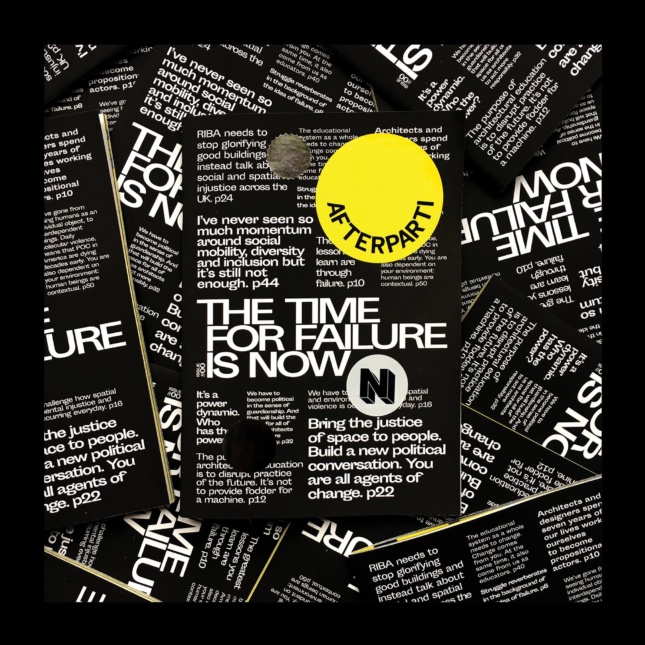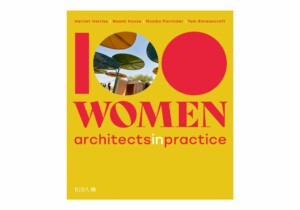“The time for failure is now” reads the front cover of Afterparti, printed emphatically in sans-serif, white type on thick, matte black paper. It’s not the only message on the magazine’s cover: “Bring the justice of space to people. Build a new political conversation. You are all the agents of change,” reads another, followed by “p22” — the page where such inspiration can be found. Already, Afterparti, a new architecture “zine” hot off the presses, feels like a call to arms.

Afterparti, I should point out, is a collective, not just a publication. In June 2018, the group held a panel discussion at the Royal College of Art in London also titled, “The time for failure is now.” The group’s inaugural members comprise Shukri Sultan; Aoi Philips; Tara Okeke; Marwa El Mubark; Thomas Aquilina; Nile Bridgeman; Samson Famusan; Josh Fenton, and Siufan Adey. Together, the collective is striving to further platforms for radical, underrepresented voices, advocating for a culture of collaboration and inclusivity. “We want to fail better,” they state inside their first magazine, which also includes an interview (read: argument) with Royal Institute of British Architects President Ben Derbyshire, survival tips and tunes for BAME (Black, Asian, and Minority Ethnic) architects, and articles from leading BAME industry professionals such as Pooja Agrawal of municipal planning initiative Public Practice and Akile Scafe-Smith of London design firm, Resolve.
AN sat down with Afterparti—who respond in this article as a collective rather than individually, as is the “parti line”—to find out more.
AN: What’s in the name “Afterparti“?
AP: Afterparti is in two parts. The term parti is something that we all share in the language of architecture. What does parti mean? A big idea, a conceptual framing device. And so we take the term ‘parti’ to connect with our architectural background and inject playfulness — by which we mean accessible, as the events we put on are for everyone. We want people to share their experiences and input on how we can make the city better for everyone. There’s an openness to the term, too. We could roll out a series of different interpretations, but hopefully, the kinds of things we write or put on or stage or curate are going to be open-ended and not too closed. We want it to be a conversation that goes beyond the normal sphere of architecture. Ignoring race, it’s often just middle-class people talking among themselves.
The term ‘Afterparti’ also suggests ourselves as a continuation of the New Architectural Writers (N.A.W.) program, as an idea, a platform, to bring together underrepresented voices.
What is the N.A.W. program? Is that how you all met?
N.A.W is a free writing program for black and minority ethnic people interested in writing about design. There was a mass email which asked: Are you under 30, based in London, interested in writing, with a background in architecture and of this minority? You kinda had to do it, it didn’t matter how busy you were — that’s how we felt at least.
Really what we’re doing is an extension of this program but at the same time is the idea of events and a zine series. It’s always about extending that conversation as well: the conversation that happens on stage can happen in print and therefore there’s an afterlife to any event.
Why have you chosen to focus on failure?
It was definitely a collective decision. Regarding the initial event we held, we wanted to find a theme for the panelists who were going to be on stage for a live debate. We wanted them to speak more openly and personally about ideas and issues that that might not be able to answer through the theme of failure. We challenged them on how they adapt and respond to failure, putting people on the spot, stopping them from giving us a readymade answer.
In fact, that’s a theme within our work. The zine is a very personal product. Whoever’s article you read, it’s a very personal piece. We put ourselves into it. The N.A.W. program came about because there’s not enough of us [minorities who are writing] out there, so we take great pride putting ourselves into our work, in part, because we have a different background to share. We are a disadvantaged generation, there is potential failure at every turn. Failure isn’t just a singular event, it’s systemic and we can develop ourselves through it.
Why a zine instead of more events?
The basis of why we came together was because we could all write in a sense and that was a common denominator. Afterparti is a lot more than just writing, everybody is doing different things and we have different skillsets. Events can take a range: we could be curating something, throwing a disco party, or something else, who knows what might come next. The zine, however, is always the reflection of those events. In this case, it builds upon the panel discussion we had at the Royal College of Art.
The zine also a way of opening up our platform to other BAME people within architecture.
What made you produce your own publication instead of writing for somewhere else?
It’s not that we disagree with everything that architectural journalism stands for, it’s just that we want a different flavor, something that represents us and how we feel about [architecture].
Aside from N.A.W., we’ve made it our own thing. There’s no glossy front cover, no building reviews. This was all a deliberate choice. We were less interested in the aesthetics of single projects — though we don’t ignore this by any stretch, we just don’t feel as if what we have to stay stems from this. Of course, we do care about aesthetics in general, our magazine is beautiful! However, all of our articles are socially minded and/or politically motivated. It’s less about a shallow, pictorial review of architecture. We are nine individuals, as has been said, all with individual takes and perspectives, on architectural practice and education and the myriad of things that entwine all of that and more together. Our approach to creating this written product comes from a place of play as well as a place of process. Plus we’ve only got so many pages as well, we want to write about the stuff that’s important — important, but often overlooked.
Did you fail along the way?
Of course! We tried to have the awareness that we are in the midst of failure, but that’s not a new thing.
What’s next for Afterparti?
We are going to try to take more opportunities with different groups and not just stay strictly architecture. We want to continue going outside that sphere: being more intersectional and maintaining accessibility.
That’s all we can say for now! Whatever the next theme is, it’s going to be about holding the relevant people in power to account. It’s always going to be a call to action.











